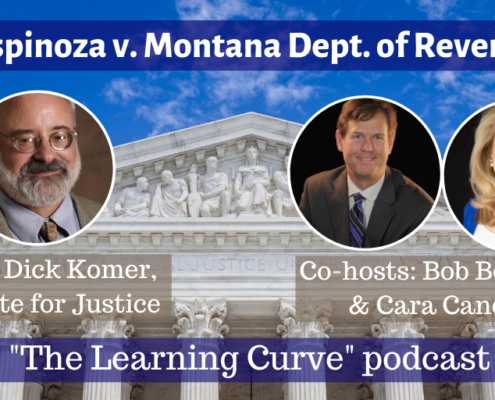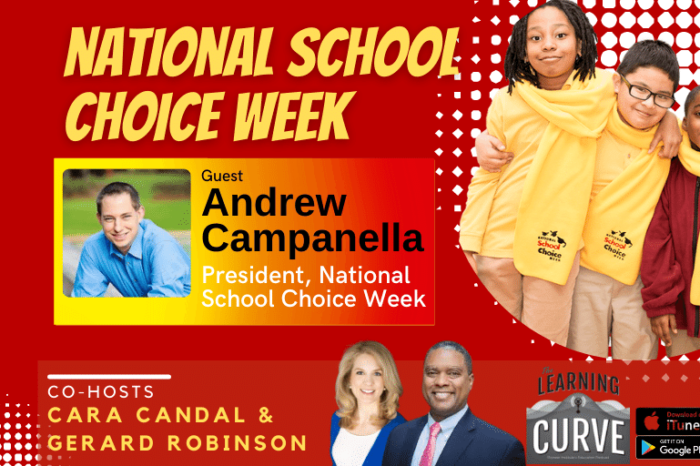Andrew Campanella on National School Choice Week
/in Blog: Education, Blog: School Choice, Charter Schools, Featured, Podcast, Related Education Blogs, School Choice /by Editorial StaffThis week on “The Learning Curve,” co-hosts Gerard Robinson and Cara Candal talk with Andrew Campanella, the president of National School Choice Week. They discuss why 2021 was called the “Year of School Choice,” and the implications of more academic options for K-12 education reform across America. They delve into the reasons why political support for even the highest performing charter public schools has eroded, the path forward to rebuild wider coalitions, and why for-profit school management companies for charters are so controversial. Andrew offers insights on innovative models that thrived during the pandemic, including micro-schools and learning pods, lessons we can draw from digital and blended learning, and how state policymakers have responded, in some cases with restrictive measures to undermine these models. Lastly, they discuss the Supreme Court’s 2020 ruling in favor of school choice advocates in the landmark Espinoza v. Montana Department of Revenue decision, the follow-on Carson v. Makin case, and its likely impact.
Related: Read Cara Candal’s new report for Pioneer Institute, “Modeling an Education Savings Account for Massachusetts.”
Stories of the Week: New York City has made incredible progress over the past three decades in improving public school students’ academic performance and graduation rates, thanks in large part to innovations such as charter schools and other, smaller high school models. West Virginia’s Hope Scholarship education savings account program is in jeopardy as a result of a lawsuit alleging it violates the state constitution because it “depletes the funding to public schools.”
Guest:
 Andrew Campanella serves as president of National School Choice Week, the nation’s largest public awareness effort for K-12 education. With the goal of informing parents of their school choice options, Andrew and the NSCW team work with more than 21,000 schools annually—along with thousands of organizations and homeschooling groups. Under Andrew’s leadership, NSCW has experienced remarkable growth, from 150 events and activities in 2011 to more than 40,000 in 2019. Andrew’s book is The School Choice Roadmap: 7 Steps to Finding the Right School for Your Child. Previously, he worked in senior level positions at the American Federation for Children, the Alliance for School Choice, and the American Board for Certification of Teacher Excellence. He grew up in New Jersey, graduated from American University in Washington, D.C., and now lives in Florida. Find him at: @andrewrcamp https://www.andrewrcamp.com
Andrew Campanella serves as president of National School Choice Week, the nation’s largest public awareness effort for K-12 education. With the goal of informing parents of their school choice options, Andrew and the NSCW team work with more than 21,000 schools annually—along with thousands of organizations and homeschooling groups. Under Andrew’s leadership, NSCW has experienced remarkable growth, from 150 events and activities in 2011 to more than 40,000 in 2019. Andrew’s book is The School Choice Roadmap: 7 Steps to Finding the Right School for Your Child. Previously, he worked in senior level positions at the American Federation for Children, the Alliance for School Choice, and the American Board for Certification of Teacher Excellence. He grew up in New Jersey, graduated from American University in Washington, D.C., and now lives in Florida. Find him at: @andrewrcamp https://www.andrewrcamp.com
The next episode will air on Weds., February 2nd, with guest, Dr. Jennifer Frey, an associate Professor of Philosophy at the University of South Carolina and fellow of the Institute for Human Ecology at the Catholic University of America.
Tweet of the Week:
We need sustainable, effective inputs that lead to measurable improvements in student achievement… Title I is an annual funding stream for schools that serve disadvantaged students… We hope Congress follows through on @POTUS commitment to triple Title I. https://t.co/dT0Fq0kElj
— Nina Rees (@Ninacharters) January 23, 2022
News Links:
Jay Mathews: Shockingly good news about New York City public high schools
https://www.washingtonpost.com/education/2022/01/23/nyc-schools-consortium-bloomberg-deblasio/
Lawsuit could delay rollout of West Virginia’s Hope Scholarship Program
Get new episodes of The Learning Curve in your inbox!
Read a Transcript of This Episode
Please excuse typos.
[00:00:00] Gerard Robinson: Listeners, Gerard Robinson, welcome back to another session of the learning curve. As you know, we bring together really good, smart, interesting people every week to talk about education, society, culture, literature, philosophy, the classics, anything that we think matters to you. And of course we can never have a learning curve.
[00:00:19] In fact, I would be behind that. If there was not someone named Cara to keep us moving forward. Her so curvy today.
[00:00:28] Cara: So many curves, I love it. And it’s national school choice week to art, which is a big deal for you. And for me, it’s, we love national school choice week, and I know you’re having a beautiful national school choice week because you’re finally out of the snow and all of that.
[00:00:44] Good stuff. So it’s wonderful , to hear your voice to happy. It’s a happy time. It
[00:00:49] is a happy time.
[00:00:50] GR: And when you think about national school choice week, it really changed the curve starting 30 years ago, at least in terms of modern school choice movement in the lives of [00:01:00] millions of families. Millions of students and millions of teachers across the board over time, who simply said, we have to do something radically different.
[00:01:10] If we want to open up the doors of opportunity to the workforce, to college, to the military. To entrepreneurship. And so there were a group of philanthropists and superintendents and teachers in the public school sector, as well as private school sector, who said, yeah, we’re going to start something new, whether it was the original school choice program in Milwaukee, whether it was the charter school program in.
[00:01:36] Minnesota that Senator Ember created, or whether it of morphed into what we now have today is education savings accounts and tax credits. So the things that we talk about 30 years ago mean a lot today, and this is a great week for us to celebrate what it has done and what it will do moving from.
[00:01:54] Cara: Absolutely. And I would also add to that, that it’s just, if we take a moment and reflect, and I [00:02:00] bet that today’s guest Andrew Campanella pres of national school choice week will reflect with us, reflect on what has actually happened. In the past 30 years, because as you point out those first programs were just were small programs, they felt like one-off programs probably to many of the parents and the legislators.
[00:02:18] And as you said, superintendent, public school, people that were advocating for these. And here we are, a lot of us have been calling 2020. The year of choice, and with national school choice week. We’re not just talking about ESS and vouchers and tax credit scholarships. We’re talking about charter schools and open enrollment laws and part time enrollment laws that are coming to fruition in so many states.
[00:02:38] So I think that I love this particular, , national school choice week moment, because it’s a time to look at how far we’ve come in. Very far, indeed. Gerard, as I’m seeing that we’ve come so far, I think we also need to recognize that there are still those who just don’t want to see this kind of [00:03:00] progress, especially if it means that kids are leaving the schools to which they are assigned.
[00:03:05] And now, as you know, Gerard, just, , this past year West Virginia, well, was it, it must have been 20, 20 West Virginia passed the first universal eligibility. Education savings account in this country, the first of its kind and what that means. Yeah. Big applause. And what that means is that basically any student in the state of West Virginia, you just have to have been enrolled in a public school.
[00:03:32] Somebody will correct me. Jason Bedrick will correct me if I’m wrong, but I think it’s for a period of six months or something, right. There’s a small prior public school enrollment requirement. I think unless you’re an incoming kindergartener can act. An education savings account in West Virginia.
[00:03:46] Now, if you would have told. Five years ago, Gerard that West Virginia West Virginia river, it was like red for ed. And I mean, that was the beginning of really, [00:04:00] and there’s, there’s some good stuff with red for ed teachers in, West Virginia, , needed their voices to be heard and they saw some changes, but red for ed is certainly not a movement that supports parent choice.
[00:04:09] If you would’ve told me. Five years ago that West Virginia would be branded with a universal ESA. I would’ve said you’re out of your mind. So, but here we are today. but all to say that, so this program, which is just about to actually be implemented, so that means applications for the program. They’re supposed to open up on March 1st and wouldn’t, you know what Gerard surprise.
[00:04:32] There’s a lawsuit. So I’m not kidding you. Yeah, exactly. , a lawsuit probably isn’t going to make much of a difference when they wait until right before the application period opens to lay it down. Right. Because they’ve had plenty of time to tractors of school choice. In this case, the education law center have had plenty of time to do this.
[00:04:55] I think that they probably realize they’re not going to get very far with this lawsuit. Instead, what they [00:05:00] would like to do is delay applications, confuse parents, confuse the people who are implementing the program and make life a little bit painful because that’s how this game is played. And of course, Gerard, , the main argument, there are many legal arguments.
[00:05:13] I’m not a lawyer, but I’m going to guess if we had our friends from IJ or any other. place that does these things on. They would tell us that these are arguments that probably don’t hold a lot of water. And , , here’s one that sounds really familiar. This is just going to drain resources from the public system, despite squads of research, demonstrating that done.
[00:05:34] It happened by and large in these types of programs. So we’re watching West Virginia. I’m not super, I hope that I’m not being cavalier, but I’m not super worried about this one. I’m more worried for those parents and students that might see their applications delayed, , because this promises to be a big one.
[00:05:49] And I can tell you. That I have been working, , in my day job with some of the fine people in West Virginia who are working to implement this program they’re doing an amazing job. So we’ll keep an eye on it. We will [00:06:00] keep our listeners updated. , but national school choice week is going to win out in the end.
[00:06:04] I think, I think the advocates of west Virginia’s hope scholarship program are going to be pleased at the end.
[00:06:10] GR: I’m so glad you mentioned the New Jersey based education law center, , who filed the lawsuit in, West Virginia. So they have been a pretty strong advocate for traditional public schools, and I’m glad to see them there as you and I have said most of our children and America will remain in public schools, traditional public schools, I should say for a long time and they need to work, but it’s so interesting that the New Jersey based education.
[00:06:34] Center, which has been at the forefront of almost 20 plus years of finance litigation work in New Jersey, where students in let’s say Newark, receive over $20,000 a year and the traditional system. And I can tell you from having worked in New Jersey, having friends with children in the system, and otherwise they’re not getting $20,000 with the results and you’ve [00:07:00] had multiple, , advocates.
[00:07:02] in that state and yet we somehow have yet to crack through to true opportunity, true equity that they’ve been arguing for. So rather than focus in the garden state on a lot of work that has to get done. Equity for fi finance for opportunity. They want to jump over and go into West Virginia and do some great work.
[00:07:23] So I take it as either a, they have too much free time on their hands to be involved in West Virginia or be they see the program West Virginia, as you say, the first type in his country as a threat, not only to their way of life in New Jersey, but it may actually awaken millions of parents across the country who may see.
[00:07:43] We need to look at something very differently. So that’s from a, , education law center perspective.
[00:07:49] Andrew: Yeah. And
[00:07:49] Cara: as you talk, I can almost hear drilled Bradford. Sorry, real quick. I can almost hear it. Feel about fire, about everything you just said about New Jersey. Like parents are waking up, but I digress.
[00:07:58] Go ahead.[00:08:00]
[00:08:00] GR: Oh, no, no. They’re waking up. And in fact, , the narrow win of the current governor of New Jersey, where the Democrats out vote Republicans two to one, it shouldn’t have been that close, but it was in part because of, , issues like this. So I’m with you. It’s another lawsuit.
[00:08:18] Guess what similar things happened in. Nevada and Arizona with a voucher program and a walking. This has gone on for over 25 years, teachers unions, they’re advocates, nonprofit organizations who have a right to protest what they believe to be a role, have a right to do so, but in most cases, I mean, in fact, , , there’s not just play around with this in the vast majority of cases.
[00:08:42] Supreme courts, lower courts have ruled in favor of the program because it is an opportunity to advance, , hope for other people. So for this hope scholarship program, we will follow what we know with interest and it’s worth mentioning. My father grew up in Charleston, West Virginia. I am also a fan of John [00:09:00] Denver.
[00:09:00] So take me home country roads. I believe this program in fact, is something to take parents where they belong. West Virginia mountain mama. Take me home country roads.
[00:09:12] Cars: You got to sing it though.
[00:09:13] GR: Come on. Oh no. Oh no, not, not this one. I don’t, I don’t have the Denver field. So I
[00:09:19] think that
[00:09:19] Cara: today, I feel like you’ve done it before, you know, that’s all right.
[00:09:22] Just leave us all hanging. That’s okay.
[00:09:24] GR: You know what? In fact I did it before and the emails I received is what made me realize I should have not sing that song.
[00:09:31] Cara: They were all from your daughters, your daughters and your wife.
[00:09:37] GR: So my story is actually from east coast, like the West Virginia story, but this one is actually about something good and something good coming out of New York city.
[00:09:47] And I say that because like Mississippi, when you mentioned the word Mississippi, it’s always something bad. And when you say New York city and education, it’s always something But our friend Jay Matthews [00:10:00] at the Washington post, who we had a chance to interview in April of 2021. Wrote a really good article and it’s titled shockingly good news about New York city public high schools.
[00:10:11] And he’s writing about a study. It’s a new study from Ray Damasio, who is a scholar at the Manhattan Institute in New York city. And Ray took a look at a reform movement that began in the early 1990s in New York. So for our listeners who. May not have an idea of what New York was like in the early 1990s.
[00:10:32] Not only were there a lot of challenges with crime, , 42nd street today. Look radically different in the early 1990s, the idea that you have so many charter schools, , in New York city today was not only unthinkable, but unheard of in the early 1990s, because it was the latter part of that decade where you have the creation of charter schools.
[00:10:54] And so you got a group of reformers who said, we’ve got to do something different. In our state. And I [00:11:00] think what we want to do is to look at new ways of assessing high schools. And so at the time it was the commissioner of education, Dr. Thomas Sobel, who announced a compact for learning. And it was an initiative that he approved and he said, listen, we’ve got really high performing high school.
[00:11:19] In New York, why don’t they tutor or mentor better yet several low-performing schools in our state and see what we can do. And so responding to that request, we had people like Stephen Phillips, who was a superintendent of New York city’s alternative high school division. And you had Debra Meyer who was a New York city principal, and the MacArthur genius award winner.
[00:11:39] Who said, you know what commissioner, we’re going to take you up , on your offer to work with some other schools and with the grant. Came an opportunity to look at new ways of evaluating schools. Well, by 1998, a group of schools formed the New York performance standards consortium. And this consortium was really focused on looking at [00:12:00] assessment models other than just a New York exam.
[00:12:04] In order to determine whether New York schools were doing well or not. And so through the consortium, they ended up creating a number of schools. In fact, up to 36 today, and those schools basically said, we’re going to do three things. We’re going to use, , literature, we’re going to , use social science research papers.
[00:12:21] We’re going to use other assessments other than just a new. Exam alone to determine whether or not we’re going to, , evaluate the schools as being great or not. And so from Ray’s study, he looked at these schools between 1994 and 2014 and identified that a. They created 359 new high schools. There were under the control of the city’s department of education and 56 publicly funded, independently operated charter schools.
[00:12:51] So that’s my number two of three. And number three, parents could choose from a wide array of options in the city. So that by [00:13:00] 2019, the high schools in question were serving 173,000 students that may not seem like. For a school system with 2 million students. But remember the majority of those students in New York, as well as in other big cities and small cities too are mostly elementary and middle.
[00:13:18] So when I say 173,000 students are served by the high schools, , under consideration now 59% of the New York high school studies. Are in those schools. So imagine how tough it was in the 1990s to say, we’re going to close a low performing school. I can tell you that’s a tough conversation because those schools tended to be some areas.
[00:13:42] They tended to be populated by black, and brown students tended to be led or the leadership of black and brown people. And all of a sudden you were seeing as whites and those from a leak communities were saying, we’re going to close your school. Wait a minute. These were our schools. So that’s a whole nother conversation.
[00:13:59] But [00:14:00] today those schools are doing some wonderful things. For example, Ray identified that if you look at the small high schools in play, the on-time graduation rate is 83%. If you go back to the time the study began, you had high schools in New York. Get this where the graduation rate was 20%.
[00:14:18] And today it’s. Quadruple really four times the number, you also have more students who are college and career ready, but guess what? You have students who are graduating, ready to go into the workforce. So what Jay Matthews is saying is that at a time we want to criticize New York about a lot of things.
[00:14:35] Here’s something that we should celebrate this organization, which, is a progressive group. We know that Ray works for Manhattan Institute founded in 1977 as a conservative group. Jay says, these are not two groups who you would often find in the same room, where guess what? On this issue, they’re in the same room.
[00:14:53] I think for superintendents, I think the state chiefs, I think for teachers and given the fact that we’re [00:15:00] going to have more than 30 gubernatorial elections of the United States and our territories, if you are a sitting governor, or if you’re someone who wants to unseat a sitting governor, I say, you should take a look at, Ray’s report and the tough decisions and the courage and the political will that it took in the 1990s to say that we’re going to get.
[00:15:18] Not get rid of the New York exam, but allow other assessment models to come in place. But those had focused on writing on research, on, communications and to see what we can do. And those schools are not populated by my kids, by your kids. They’re populated by the children. Who for a holster reasons may not find themselves on the fast track to college or to the workforce.
[00:15:43] So I think it’s a great article, something to celebrate school choice week, because we only think it’s about VAR vouchers, charters and tax credits. It really is about school choice. And this was an.
[00:15:56] Cara: Yeah, I love it charge. Not only cause you’re taking me back to the [00:16:00] nineties and , the nineties were great time.
[00:16:05] I can’t, I can’t remember them. No, so there’s two things that come to mind. the first is that you’re talking about this group of people and as you noted, some of them were very progressive. I think Debra Meyer, I mean, In so many, I admire her work to this day. I don’t have to agree with her, but boy, I admire what folks like Deborah and others have done.
[00:16:24] And, the fact of the matter is, is that when I think back to education reform, especially in the nineties, and if you read about new study, but it’s not that there wasn’t controversy, but people did find ways to come together in the name of what in the name of kit. Right. So whether it was about giving more choice within the public school context, or to your point about thinking about other evaluation and assessment models, folks came together, put their heads together and made it work.
[00:16:51] And I like so many things in our heightened American society, , mainly, probably due to all of us being really mean to each other on [00:17:00] Twitter. and I know Twitter really is marking me as old because that’s not what the kids use, but, , it’s a hard.
[00:17:05] Mix to find these days and we needed, and we need it desperately. the other thing that comes to mind, Gerard is that just this whole conversation around finding something other than the New York exam to help move these schools forward, to help figure out how to open up better high quality emphasis on high quality options to kids and give them what they need.
[00:17:25] And, you know, we’ve talked about it on this show before in the context of. Is accountability going way or what are we going to do? But this is a moment where we need a group like this, where we need these minds folks to think about like, what is the next. , generation of assessments look like, and they might not look like , what you and I know, or, remember, or help to, to design a lot of those back in the day.
[00:17:48] , but what does it look like and how does it factor into the information that we give parents in the context of holding schools accountable and being transparent so that parents can. [00:18:00] Informed choices in places. Well, I would hope everywhere, but in places like New York city, and I think you’re right, New York city often gets a bad rap often because it’s fun, especially for us Bostonians to, feel superior in many ways to what’s going on in New York.
[00:18:15] Not that we have much to feel superior about when it comes to one of our big city school systems, but there’s a lot of innovation, a lot of good going on in New York and all driven by some incredibly creative, innovative. Caring people, people who really have the best interest of kids and families at heart.
[00:18:33] And I will, end with a little slap on the wrist for the Commonwealth of Massachusetts, which I fear by, having some pretty draconian, for example, charter school laws. We’ve lost a lot of talent to places like New York, where folks have flexibility to go and open the schools that they want to run.
[00:18:50] And well. families from all over that city into these really innovative high-performing schools, , we’ve lost that option in a place like Massachusetts. We’ve foreclosed it a [00:19:00] long time ago. So thank you for bringing that to light to east coast centric stories this week, Gerard, but, I appreciate them both.
[00:19:06] So, I’m so glad we
[00:19:07] GR: talked about Debra, , because we can agree to disagree and for our listeners who only know. The school reform movement as being one where a Berlin wall separates us from them. There was a time in the nineties where someone like Debra Meyer could be a fellow at the Annenberg Institute for school reform at brown university, with Dr.
[00:19:29] Howard fuller, who was a supporter of school vouchers. And yet they were the same as. Could work together, dine together, break bread, and then leave and do something different. And unfortunately, too many of millennials in particular, it’s not your fault. It’s the fault of older generations. We haven’t shown them the sample.
[00:19:49] Oh, no, of course. Not of course now. Oh no, no, no.
[00:19:56] Cara: Gen X or
[00:19:58] GR: millennial gen [00:20:00] X-ers we haven’t shown you. And a good example that you can actually, talk, shop and agree to disagree without trying to Gaslight someone, , deep platform them different time. And I think it’s going to take people who have the will to be unpopular, to say it, but to find common ground for common opportunity for your Commonwealth and my Commonwealth.
[00:20:24] Cara: Right Kylie. We disagree all the time and we’re both okay. Being unpopular. So that’s what we bring to and
[00:20:32] GR: get off air. You ultimately emailed me and said, you know what? were able to give you. And so, and I’ll do the same because you’ll come back to me and I’ll tell you off the lie. So
[00:20:42] Cara: every single time, okay.
[00:20:44] We have Andrew Campanella. Waiting for us, Gerard. I’m sure he’s just so eager, but I know he is because it’s national school choice week and it’s only one week out of the year. So, there is a lot to do, especially for a guy like Andrew. So we’re going to be [00:21:00] back with him guys in just, um,
[00:21:21] Welcome back everybody. It is national school choice week. And to that end, we have with us, the president of national school choice week, Mr. Andrew Campanella, he has been with us before. We are lucky to have him back as so many of you know, national school choice week is the nation’s largest public awareness effort for K to 12 education.
[00:21:40] I know that your art is wearing his yellow scarf right now. the. Um, NSC w is to inform parents of their choice actions. It’s just so important. We don’t necessarily inform parents wouldn’t pass legislation, right? So we need somebody to do it for us, Andrew and the NSC w team work with more than 21,000 schools annually, [00:22:00] along with thousands of organizations and homeschooling groups under Andrew’s leadership, a CW has experienced remarkable growth from 150 events and activities in 2011.
[00:22:11] 40,000 in 2019, his book, which he has been on to talk with us about before is called the school choice, roadmap seven steps to finding the right school for your child. Previously, Andrew worked in senior level positions at the American Federation for children, the Alliance for school choice and the American board for certification of teacher excellence.
[00:22:31] He grew up in New Jersey, which I have to tell you. We’ve just been talking about Gerard nigh before this and graduated from American university in Washington. He now lives in sunny, Florida, because he knows where the weather is better and where, and by the way, there’s lots of school choice. So Andrew, welcome to the learning curve.
[00:22:49] Andrew: Thank you so much. I am thrilled to be here. Yay.
[00:22:52] Cara: Well, we know you’ve been talking a lot this week, with a lot of folks like us been on a lot of podcasts, but we’re going to just like dive right in [00:23:00] and get a little wonky here. So we’re all calling. Yeah. I know you love to work it out, right.
[00:23:04] That’s what we’re here for
[00:23:07] Andrew: you. But I do. You do.
[00:23:09] Cara: I know you do. So, we’ve all been . Looking at 2021 and calling it the year of school choice. I think probably at the beginning of that year, we thought it was. The year of the learning pod, which is only one form of school choice, but here we are with so many states, I mean, just more than ever before, either expanding their private school choice programs mainly, or establishing new ones.
[00:23:31] We were talking at the outset of this show about the hope scholarship program on West Virginia, which is of course being challenged, but, school choice is, all of these things and so much more. So I’d love for you to talk to our list. About, 20, 21, what happened? not just in private school choice, but what we’re seeing in, other places in public school choice and the homeschooling movement.
[00:23:53] and what do you think are the implications for ed reform
[00:23:57] Andrew: going forward? So I am thrilled [00:24:00] with everything that happened in 2021, not just what happened in states, but the fact that. Organically invented an almost brand new form of school choice in learning pods and expanded the use of micro schools exponentially.
[00:24:15] Talk about innovation coming from the grassroots and individual families. We saw it, but also states expanding options. And that is really, really important to open the doors of opportunity. And we’ve talked a lot about. Through school choice week. And a lot of our partners have talked about the private school choice programs that have been expanded, but it was a really good year for public sector choice as well.
[00:24:37] Oklahoma passed the state’s first open enrollment law, allowing families to choose public schools outside of zones or districts, which I think is a huge step for Oklahoma. Other states that have programs like that. Three states, Iowa, west, Virginia, and Wyoming took steps to expand charters in their states, by allowing for multiple charter school [00:25:00] authorizers, which is essential and a state that no one talks about in terms of expanding school choice, Rhode Island opened the first full-time online public school last year, which I’m excited about because.
[00:25:12] A great option for family. So I think the implications for kids, moms and dads teachers, and the broader movement for school choice is incredibly positive.
[00:25:22] Cara: Yeah, I would agree with you. I want to pick up on something you said though. So you mentioned Oklahoma and open enrollment. Now, when I think a lot of us more when we’re talking about 20, 21, at least folks in my, swearing who I spend my day-to-day with a lot of us, we’re talking about private school choice, right?
[00:25:37] We’re pretty over the moon that , we doubled the number of ESS in the country, et cetera, but I’m so happy that you bring up public school choice in not just in the form of charter schools, because. there are a lot of ways that states can expand options, including open enrollment and part-time enrollment.
[00:25:52] Do you think Andrew, like, to what extent could we be looking at the year of public school choice in 2022?
[00:25:58] Andrew: That is a really good [00:26:00] question. Boy, would I love that because what parents tell us in our surveys is that they really want more public school options and they want to be able to choose. District schools outside of their geographic zones, which often make no sense to anybody, especially families and outside of their districts.
[00:26:18] And if you think about it, there are more traditional public schools out there than any other type of school. And if families had these options and those options were mandatory for a state mandating that a district accept kids from other districts and other zones, not these voluntary programs that most states have, which usually use.
[00:26:36] Very few transfers. We would see actually more students in the public system, which really goes to debunking or refuting the argument that choice in any way hurts traditional public schools. So I would encourage anybody out there to fight just as hard for open enrollment as you do for charters, as you do for private school choice, as you do for [00:27:00] online public schools, flexible homeschooling laws and district based magnet schools.
[00:27:05] It benefits families, number one. And it’s also good for them.
[00:27:08] Cara: Yeah, couldn’t agree more and encourage people to go on and figure out what open enrollment law actually looks like in your state, because in too many states it’s a really, I’m not very open. We’ll put it that way.
[00:27:19] Andrew: And people say we have open enrollment, but you don’t really have open enrollment if it’s all voluntary.
[00:27:24] And the district can say, we’re only going to take top athletes. We’re only going to take kids who have a certain GPA. That’s not really open enrollment. You have to make it mandatory. If the law is going to actually be flexible for.
[00:27:37] Cara: Amen to that. want to ask you about another form of public school choice, you already mentioned charters, so, and you mentioned in yea that three states did expand charter school options, this past year.
[00:27:50] But I think that I would put to you that it hasn’t been a particularly great time for charter schools in, the past couple of years, you know, everything [00:28:00] from watching federal funds go down the drain to just, I’ll call it. And this is my take. Nobody else’s necessarily, but just this shift where it used to be sort of like a bipartisan thing, that even Democrats and Republicans could find some common ground on charter schools.
[00:28:16] that seems to know. Be there as much anymore. And it worries me because I don’t have to tell you, boy, this country is home to some phenomenal charter schools. and I, feel like it’s a time where a lot of charter school leaders are sort of putting their head down and doing the hard work, afraid that, , good thing they’ve got going, it’s going to be taken away.
[00:28:34] what’s your take on this, Andrew?
[00:28:36] Andrew: I’m concerned as well. I think there’s good news. And there’s also worrisome news. I think on the good news side, you have states like Colorado. Spending $250 million for transportation grant and funding for public charter schools, which is incredibly beneficial and will open up access to charters for so many more families and states like New Jersey for the first time approving funds for charter school facilities.
[00:28:58] That’s very [00:29:00] promising. But, we have cities like New York, where for the last several years, there was a mayor who is not friendly to public charter schools. Now there is hopefully things will change there. I think that there has been more of a shift among Republican elected officials on the private school choice.
[00:29:17] End of. In many cases are supportive of charters as well. But I think that some of the democratic supporters of public charter schools have been less vocal than they have in the past. One of the reasons for this, I think is that there are too many school choice, purity tests on both sides of the political equation.
[00:29:37] Some folks who support private school choice won’t give a democratic elected official, any. For supporting charter schools or open enrollment or online public schools, just because that elected official may have opposed the private school choice program. They’re branded as the enemy. And on the other side of the equation, folks who oppose school
[00:29:57] GR: choice won’t give any [00:30:00] credit
[00:30:00] Andrew: at all to somebody who, may be an incredibly staunch defender of public education, but also supports.
[00:30:09] They are branded and enemy as well because they supported opportunities for families instead of just sticking with a one size fits all model. So we need to get rid of these purity tests. There are people who might not agree with every policy when it comes to school choice, but we can count them in our.
[00:30:24] Cara: Yeah, I really am really glad you brought that up prior to bringing your Android. And I were just longing for the nineties when people , , had a little bit more capacity to agree, to disagree, to make cool things happen
[00:30:34] Andrew: for kids. But one of the things I think is challenging here is. the reasons that people support school choice are so different now, in terms of you have folks supporting school choice for so many diverse and different reasons that all of us who support school choice, just have to recognize and accept that there are other people within the movement who supported for completely different reasons.
[00:30:57] They might have completely different [00:31:00] ideologies than ours, completely different backgrounds than our. And yet we are in the same camp. So let’s stop fighting over whatever the national media wants to throw at us today, whether it’s masks or curriculum or things like that, and recognize that we actually agree on the solution to the challenge.
[00:31:20] And that is giving families opportunities. Yes,
[00:31:24] Cara: those opportunities shouldn’t exist regardless of whatever else is going on at the moment in this crazy world lately, at the outset, you mentioned micro schools and learning pods. these really ground up parents centered parent driven innovation.
[00:31:39] And, we saw it at the beginning of the pandemic, especially as pods were getting tons of attention, fear that some states and some states did sort of try and put restrictions around them for fear that they would get too popular. what are you seeing in regard to states making it easy or not so easy [00:32:00] for micro schools, learning pods and even homeschooling, which I know some homeschooling parents get nervous.
[00:32:06] When, , new innovations like this come online because they don’t want somebody to get a terrible idea to start regulating or restricting their right to homeschool. So can you talk a little bit about what you’re seeing in terms of states making it easier or difficult for these innovations to flow?
[00:32:22] Andrew: Sure. So I’ll start with homeschooling. I define a great homeschooling environment in a state as one where the state does not impose a lot of barriers or hurdles for a family who wants to homeschool their kids. It doesn’t create a ton of restrictions and some states that do that really well. include Texas, Idaho, Iowa, New Jersey.
[00:32:45] I have some of the most accommodating homeschooling laws in the country and some of the most restrictive you’ll find in Pennsylvania. New York and Massachusetts. I like to give bonus points for the state that not only has the least restrictive homes going up, but [00:33:00] also allow students who are homeschooled to access public school classes or sports.
[00:33:04] sometimes they’re called Teebo laws other times. Other things, but some states that allow that include Alaska, Illinois, and Minnesota, and those allow homeschooling families to tap into what their tax dollars are paying for. In addition to educating their kids in the home. So micro schools and learning pods on the learning pod front, there’s really two types of learning pods.
[00:33:24] One where parents will pull their kids out of their existing school. So unenroll their child. Technically considered a homeschooling family. And then they’re getting together with other kids who are also homeschooled and educated together at the same time. Some states have laws that say, if you have more than two kids or two families together, and you’re doing this, you have either created a private school or you need to get government, state, or district permission to operate this learning pod states that have some restrictions like that, , include Pennsylvania and even South [00:34:00] Carolina.
[00:34:00] People really need to check out our website. Cause we have a, , state-by-state breakdown of what you have to do. If you’re going to create a learning plan. Now there are other states where there are no restrictions at all. So it’s really a mixed bag. The other type of learning pod is where kids stay enrolled in their bricks and mortar school and they just get together to learn together.
[00:34:19] And there are usually no restrictions on that type of, , Learning together. We call them learning support pods in any state. So you’re really not going to get yourself in any trouble or inadvertently run a foul of any state laws. If you do that,
[00:34:33] GR: Andrew, how are
[00:34:34] Andrew: you? I am great. How are you? Good.
[00:34:38] GR: Well, thank you so much for giving us a solid background on the options that we have today.
[00:34:44] Let’s shift to talk about law because so many of our school choice laws have been challenged in court, both public and private. And in 2020, we had the Espinoza case, which really changed the dynamic as relates to the Blaine amendment. But we also know there’s a [00:35:00] current case before the Supreme court.
[00:35:01] From the state of Maine. , you’ve got a crystal ball. You’ve seen some of this in practice. If the Supreme court rules in favor of the families in may. how do you think this is going to influence the school choice movement moving forward?
[00:35:15] Andrew: Well, I think the quick answer is that if there is a school choice, favorable ruling in the Karen versus making case, that main case, what it really means is that families who access that states town tuitioning program, which allows families who have kids.
[00:35:31] And they live in an area without a traditional public school. And I know people are shocked to hear that, that there are places in the country that don’t have traditional public schools. They provide those families with vouchers or scholarships to send their kids to a private school. But under the current main law families cannot choose a faith-based school as their private school option.
[00:35:50] So that’s being challenged in court. If school choice supporters win that case, then families will have more options in Maine with that town tuition program. And it [00:36:00] will further. He rode the Blaine and baby Blaine amendments that have largely been struck down as a result of Espinosa, but still exists in some form today in state laws, in a variety of places across the country.
[00:36:15] Now will that open up more opportunities for families? It really depends. And it depends because state legislatures need to create programs. Allow for those opportunities. If 2021 is any indication with education savings accounts being passed in a variety of different states and an expansion to a lot of tax credit, scholarship programs, existing state funded scholarship programs, special needs scholarship programs.
[00:36:40] I think that the future could be quite promising on those from.
[00:36:44] GR: Let’s talk about organizations now, you and I both know that for-profit companies are involved in traditional public education in many ways, whether it’s transportation, computers, desks, everything. And yet, when we talk about the role of for-profits in education day, some house become [00:37:00] evil.
[00:37:00] Can we talk about the free market parent-driven models in education, in the public sector without a demonizing for-profit was showing how they’re actually opening up a door of opportunity that non-for-profits alone.
[00:37:15] Andrew: Well, I’m glad you phrased it that way, Gerard, because I agree with you. And every time I hear this being discussed by somebody who opposes school choice, it is one big, massive red herring and the people who usually promote this argument, the scary idea of public money going to a for-profit entity are usually, and I don’t usually bring them up because I don’t like ad hominem attacks, but this one is quite specific national teacher’s union.
[00:37:41] And what people need to know is that unions are literally in the business of buying and selling benefits from for-profit providers and they earn commissions and money from the provision of those benefits. So anytime I hear. Criticism of any profit motive [00:38:00] in K-12 education. I think that it’s disingenuous and it ignores the reality that you will never have a purely non-profit model of anything in the United States.
[00:38:12] And nor should anyone want that. Having for-profit companies involved in things, whether it’s textbooks, whether it’s curriculum, whether it’s transportation, like you said, whether it’s school lunches, whether it’s chestnuts, Oriel services, those drive down costs for taxpayers. That is a good thing and increases, , what we actually get for our tax dollars.
[00:38:33] So. To criticize for-profit providers just as they relate to education, or just as they relate specifically to charter schools, which is where we see this. Come into place the most, I think is a bad faith argument. And I’d be willing to have this argument with folks who oppose school choice, the minute that they take all of the state pension funds out of the stock market, because those are for-profit equities.
[00:38:57] The minute that they force [00:39:00] people to use snap benefits in a non-profit grocery store. Good luck finding one of those, , or when they say that you can not. Your health benefits, a for-profit hospital, or when you can’t use your housing voucher at a for-profit apartment building, no one would ever say those things because it makes no sense and it hurts people, but yet folks are fine with hurting kids by denying them opportunity.
[00:39:24] To me, it just doesn’t wash.
[00:39:26] GR: So interesting. You mentioned housing vouchers because it’s actually called as you, and I know the section eight housing voucher program, which is the largest program in the country funded to support low income families, to get them out of tough neighborhoods and into housing, , in better neighborhoods often with quote unquote, better schools.
[00:39:44] And if you look at the pension funds and particularly the return on investment into. equity firms and for-profit endeavors. There are a lot of teachers in the public school sector who are going to retire with some comfort and some dignity because of those investments. So [00:40:00] thanks for bringing that up.
[00:40:01] Let’s just go ahead and that
[00:40:03] Andrew: money in government bonds right now. I don’t think so.
[00:40:06] GR: come on folks. Yeah. Had this conversation at the pioneer Institute several years ago, with the president of the Massachusetts teachers association, who raised the question, I just happened to look at the return on investment for the investment of the Massachusetts teacher association.
[00:40:24] And it was a much better return on investment in the equity sector than in government bonds. But for all the points you mentioned, well, let me close out with the last question. , you have had an opportunity to see the. Of COVID on a lot of families and we’re still dealing with it from your position.
[00:40:41] What are the key lessons drawn from digital blended and remote learning that policymakers and school choice advocates need to embrace. As we look forward to continuing our push for more options and broader portfolios with families in 2022.
[00:40:56] Andrew: Well, great question first. I want to say [00:41:00] that to every family out there and to every educator who has gone through difficult times in the last 24 months, you have my sympathies and I know it’s been really, really hard for parents and hard for teachers, , related to virtual learning and online schooling, which are two different things as you guys, very well know.
[00:41:15] I think we have a few lessons we can take away. The first is this, and this is a lesson just for school choice advocates. And that is. You always should support all the options that are out there and available because in the long run, you never win. By trying to tell families that you, as a school choice advocate are in the better position to gauge quality than they are.
[00:41:37] And what we saw for a long time was a lot of folks who were extensively in the school choice movement, but decided to use. Full-time virtual schools as their scapegoat or punching bag. And I think when COVID hit and a lot of families had to go to crisis, remote learning folks within the movement saw that these full-time online [00:42:00] schools were actually.
[00:42:01] A remarkably better job than they’ve ever gotten credit for. So that’s the first lesson is don’t punch people because you never know where you’re going to realize that they were actually doing good work. The second thing is a lesson for states, and that is if you have to go remote, go with actual providers who know how to do this, because I know that a lot of families in different states that have used, for example, Florida virtual school.
[00:42:25] Throughout the pandemic. Some states had a partnership with Florida. They had a much better experience than kids who went into these zoom bay. Emergency crisis, remote learning settings that nobody had been trained to do that we’re exhausting. The kids that had low attendance rates and were really difficult for families to connect to because of lack of internet devices, things like that.
[00:42:49] So use trusted providers. And the third thing is I hope nobody ever confuses crisis emergency remote learning, which is what many families experienced in the last two years with actual [00:43:00] full-time online school. Developed by professionals over decade and perfecting the art , of really helping kids acquire knowledge using technology.
[00:43:10] Cara: Here here. I mean, wow. very well put with regard to digital learning because I think, parents probably didn’t even realize, , how restrictive some online digital learning laws were and Boyle boy you’re right. Florida virtual school did a bunch. and I’m going to take one more thing from what you said, Andrew, and I’m going to at the dinner table tonight, I’m telling everybody don’t punch people.
[00:43:31] I love that. It’s been sort of a theme for the day and we’re all going to take that away. Andrew Campanella. Thank you so much for your work. Thank you so much for elevating. Just how important it is to give kids in parents choices. You guys work really hard all year round to bring us this week. And it’s a great one.
[00:43:51] We look forward to it every year. We appreciate you coming on the learning curve today, and I’m sure you’ve got lots of events to get to. We’re going to throw on our yellow [00:44:00] scarves and support you all the way. So take good care until the next time we get to talk to you.
[00:44:05] Andrew: Thank you guys. Very, very much.
[00:44:46] GR: So Kara, my tweet of the week is from our friend and someone who’s grown. This show, Nina Reese. She’s. Now on January 23rd, we need sustainable effective inputs that lead to measurable improvements in [00:45:00] student achievement. Title one is an annual funding stream for schools that serve disadvantaged students.
[00:45:06] We hope Congress will follow through on president Biden’s commitment to triple title one funding. All I say is I’m with. Yeah.
[00:45:15] Cara: And all I say is Nina Reese, always a class act, just absolutely. one of my favorite people in this space, she gets it right more often than.
[00:45:25] And Gerard next week, as I think you already know is national Catholic schools week. We a week for everything around here and we live it. National Catholic schools week is very important. We are going to be speaking with Dr. Jennifer Frey. She is an associate professor of philosophy at the university of South Carolina and fellow of the Institute for human ecology at the Catholic university.
[00:45:45] Looking forward to reconnect and hearing more about your yellow scarf and what you did for national school choice week. And in speaking with Dr. Jennifer Frey until then Gerard, go outside and enjoy the sun,[00:46:00] , enjoy the south. And we will, think of you up here as we freeze in a great white north by choice.
[00:46:06] I understand,
[00:46:07] GR: take care. Have a great week. You
[00:46:09] Cara: too.
Recent Episodes:
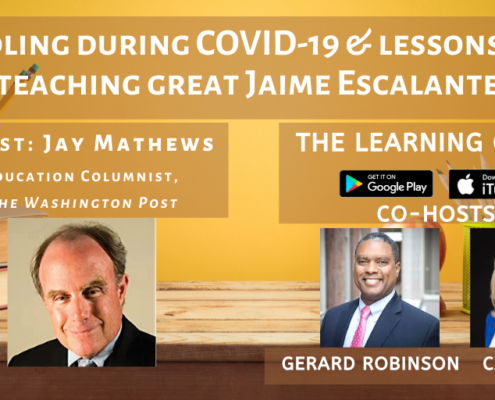
The Washington Post’s Jay Mathews on schooling during COVID-19 & lessons from teaching great Jaime Escalante
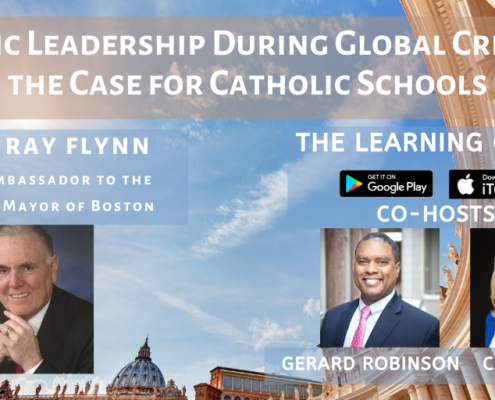
Ambassador Ray Flynn on Public Leadership During Global Crisis & the Case for Catholic Schools
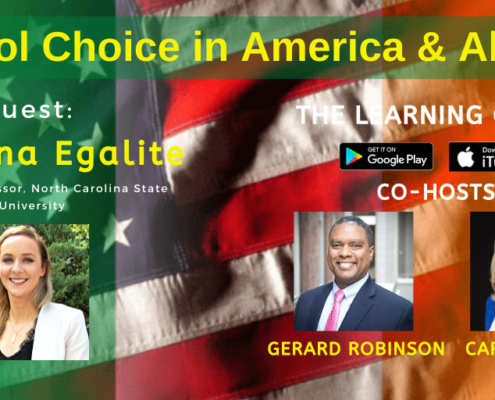
NC State’s Anna Egalite on School Choice in America & Abroad
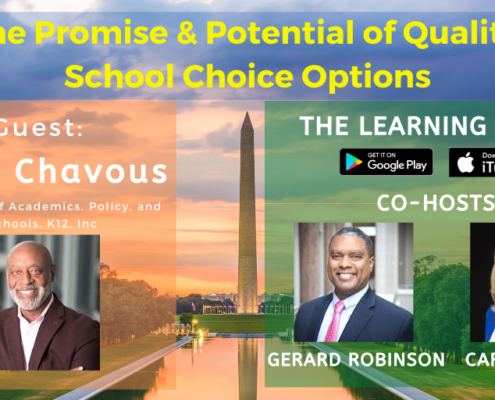
Kevin Chavous on the Promise & Potential of Quality School Choice Options
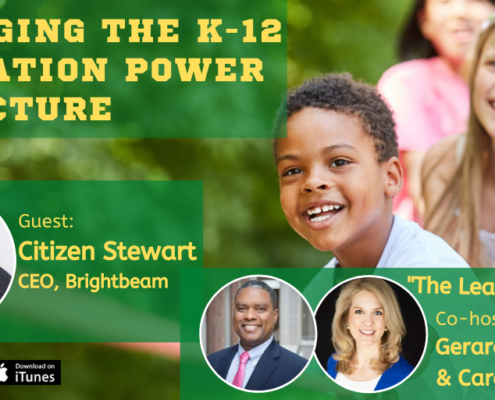
Citizen Stewart on Changing the K-12 Education Power Structure
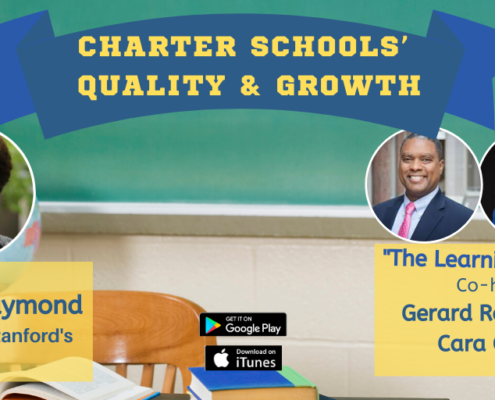
CREDO’s Macke Raymond on Charter Schools’ Quality & Growth
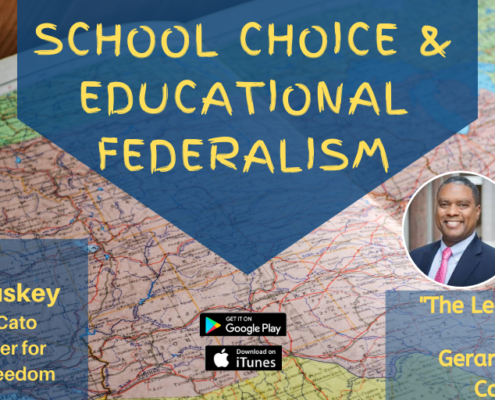
Cato’s Neal McCluskey on School Choice & Educational Federalism
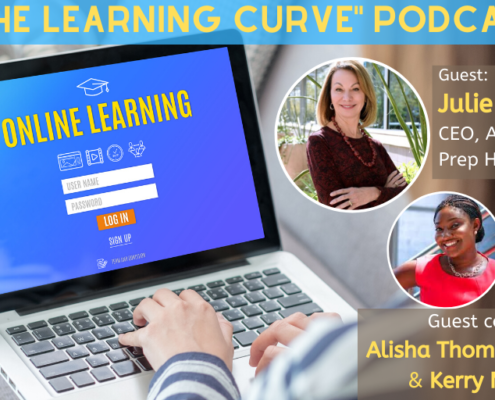
Julie Young, Virtual Schooling Pioneer
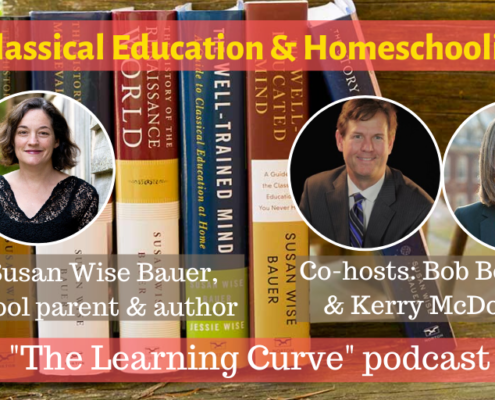
Susan Wise Bauer on Classical Education & Homeschooling
